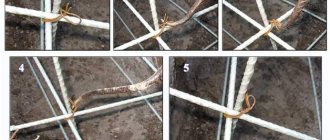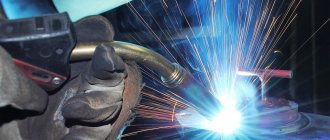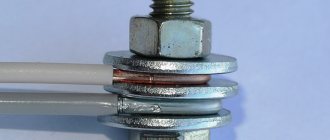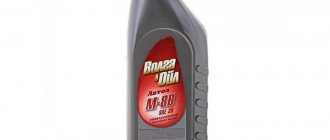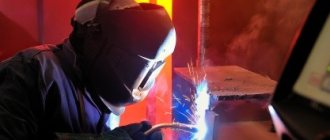Foundations without reinforcement may collapse due to thermal expansion of moisture that remains in the concrete after it hardens.
To compensate for the stretching of foundation structures and prevent the occurrence of cracks, they use metal reinforcement cages.
When designing and installing them, the question becomes relevant: which connection method will be more optimal - knitting or welding?
Fixation in reinforcement and dependence on loads
Private houses, dachas, outbuildings, workshops and other low-rise buildings place a relatively small load on the foundations. In lightly loaded foundations, it is advisable to use the method of manual or machine tying of reinforcement. Metal rods are tied with a special knitting wire.
Note ! The knitting method does not allow achieving rigid and immovable connections. Under high loads, the binding wire can stretch, which causes a gap to appear between the reinforcing bars at the points where they are tied, and the strength of the frame decreases.
In the foundations of massive multi-story buildings, displacement of reinforcing bars relative to each other is strictly unacceptable. Therefore, instead of binding wire, all frame elements in foundations are connected with rigid and fixed welded joints. This method allows you to achieve maximum stability of the reinforcing structure and significantly increase its strength.
Calculator for calculating the amount of wire for tying the reinforcement cage of a strip foundation
It is not enough to know how to knit reinforcement correctly; you also need to carry out calculations. To do this, it is necessary to take into account the following indicators:
- indentations between clamps;
- number of longitudinal reinforcement rods;
- base length;
- double sealing of corners.
A modern calculator, which you can use online, will allow you not only to determine the amount of wire for tying the frame under the foundation, but also calculate the approximate number of joints.
Can welding be used?
The use of welded joints when reinforcing foundations is not prohibited by SNiP rules. But there are a number of important conditions that must be observed when welding reinforcement for foundation structures:
It is necessary to very carefully control the quality of the metal rods that will be used to create the reinforcing lattice.
Products must not have any defects or areas of corrosion. Due to rust, the strength and reliability of welded joints can sharply deteriorate.If there is corrosion on the steel rods, they must be replaced with new ones or thoroughly cleaned of oxides.
- Before carrying out construction work, it is imperative to carry out geodetic research at the construction site, analyze the properties of soils and seismic conditions.
Welding can only be used in the foundations of buildings that are erected on soils with minimal shrinkage. Increased seismic activity and prolonged soil shrinkage can lead to damage to the integrity of welded joints. In such cases, this method is unacceptable. - Reinforcement should be welded only by spot welding. Seam, relief, arc (non-contact) and other types of welding are not recommended, since using such technologies can burn out the reinforcement. This will have a bad effect on the properties of the metal and, accordingly, on the strength of the foundation frame.
Link recommendations
Before you start work, prepare the material and tools. The reinforcement must be pre-cut if necessary. Decide in advance on the shape of the reinforcement cage. We recommend connecting the rods so that they form a square at the junction.
If you are assembling the frame outside, then this can be done directly on the ground. One side of the “square” will require three reinforcements. Take three rods and place them parallel to each other. First place a couple of bricks or boards under the bars so that the reinforcement does not touch the soil.
The distance between the rods should be from 4 to 6 cm. The pitch should be constant so that the load is distributed evenly. That is, if, when assembling the first side of the frame, you made a gap of 5 cm between the three rods, then maintain it throughout the entire time.
Make clamps from thick wire. The picture below shows the location of the reinforcing bars and clamps.
Now you must connect the rods and clamps. For this, a special thin wire and hook are used. There are many ways to make a knot. One of them is shown in the picture below. Instead of a hook, you can use a special gun, but then the cost of the work will increase.
One loop is used to connect the reinforcement. There is a method of joining with two loops, but it is rarely used since one loop is enough to provide sufficient rigidity. Yes, and it’s not difficult to learn. Watch a few videos on the Internet. It describes and shows in detail the process of tying the reinforcement.
The standard wire consumption per knot is about 20 cm. A beginner will need more material, but you need to strive for this indicator so as not to overpay for wire.
Remember: the better the frame is knitted, the better. Of course, if you burst one or two ligaments, the foundation will not suffer much. It is important that the structure is rigid when pouring concrete. But if there are a lot of such flaws, then the frame will become movable, and this is bad. Make sure that the reinforcement is tightened with sufficient force.
Advantages and disadvantages
Welding reinforcement in building foundations has several important advantages:
- Rigidity of connections. Unlike knitting wire, which is subject to stretching, welding provides a rigid and immovable fastening of the reinforcing rods. Frames constructed using this method can withstand enormous static loads.
- Relatively low labor intensity of work. Tying the reinforcement frame may require 2-3 times more time and labor resources than welding. The use of electric welding allows you to speed up the construction process without compromising the quality of work (provided that the reinforcement of the foundation is carried out by highly qualified welders).
- Increasing the bearing capacity of the foundation. This is crucial in the construction of heavily loaded foundations on which multi-story buildings for residential, industrial, commercial or other purposes are erected.
Welding is also better suited for connecting large-section reinforcing bars (from 30 mm or more), when working with which it is difficult to use strapping.
On a note. The main disadvantage of welded joints is that they are less able to withstand uneven loads that occur on the foundation when soil layers are displaced.
Therefore, their reliability largely depends on the properties of the rock. Also, if errors are made during the welding process, irreversible changes in the structure of the metal can occur, therefore increased demands are placed on the professionalism and competence of welders.
Minimizing negative impacts
It is clear that natural factors cannot be overcome (at least in most cases). However, it is considered quite possible to reduce the negative impact of welding on metal in construction work. Experts have developed a whole range of measures aimed at minimizing losses during welding operations.
- Selection of reinforcement for the frame. It is strongly recommended to use rods classified as A400C or A500C. Their diameter and carbon content in the metal are optimal for equipping the supporting structure by welding.
- Selection of electrodes. They must correspond to the diameter of the elements assembled into the frame. If relatively thin rods are to be used, most commercially available electrodes will suffice. If the reinforcement frame is constructed from elements with a diameter greater than 14 mm, you will have to stock up on specialized electrodes for these cases. Moreover, it is advisable to purchase those that are designed to work with low-carbon steel. Such electrodes have a less intense impact on the metal during welding and will provide a structure with greater strength.
- Welding machine. For welding reinforcement for the foundation, when connecting reinforcing elements, it is recommended to use equipment with continuously variable control of the supplied current. Insufficient current will not make it possible to achieve a reliable, durable and high-quality seam, which can subsequently lead to subsidence of the foundation, or even to the destruction of the building as a whole. An excessively intense current will overheat the metal, and the reinforcing element will become brittle after cooling.
Need a welding machine
- In order for the welded joint to be as strong as possible, it is necessary to press the welded elements together as tightly as possible. However, this is quite difficult to do. Some craftsmen advise using a grinding tool. The rods are cleaned to relative smoothness, and the connection area of the reinforcement increases.
And finally, there are recommendations in construction work for treating seams with anti-corrosion compounds. At the point of welding, the metal becomes more vulnerable to moisture, and the solution from which the foundation is poured contains plenty of it and takes a long time to dry.
Technological features and stages
The assembly of metal reinforcement frames using electric welding is performed in the following sequence:
Before starting work, it is necessary to conduct thorough quality control and check the fittings for compliance with all requirements and standards.
Read more about what kind of fittings are needed for a private home and what is best used in industry here.Steel rods that do not meet the standards are rejected and not allowed to be used in the foundation frame.
- The reinforcement is marked, straightened and cut into fragments of specified sizes. Using abrasive tools, workers carefully clean each rod.
- Next, using welding, the first part of the volumetric frame for the concrete foundation is created. The reinforcing bars are welded together at certain points (according to the markings) and a flat rectangular structure is obtained.
- Then the flat parts of the frame are connected into one volumetric structure, alternately fixing them vertically above each other and connecting them with special conductors.
First, these parts are fixed with strapping, after which they are welded in a certain sequence. The sequence of creating spot welded joints is selected in such a way as to prevent overheating of structures. To do this, the frame is first boiled on one side, then on the opposite side (during this time the metal on the first side will have time to cool).
From the video you will learn how to properly weld reinforcement for the foundation:
What is fittings needed for?
To compensate for tensile loads that are dangerous for concrete, a special reinforcing structure is placed inside its “body” - a reinforcing frame. During installation, it is given the shape of a lattice, positioned in such a way as to absorb tensile stresses. The simplest version of this design is several reinforcing bars connected to each other and placed inside the formwork before pouring concrete.
In more complex cases (when it is necessary to strengthen the foundation as much as possible), the frame is assembled from a combination of main and auxiliary rods. The first ones are made from thicker blanks and are placed longitudinally.
Auxiliary rods are needed only to support the longitudinal bars and are required only when pouring.
The main load after the mixture hardens (during operation of the foundation) falls on the working rods. The auxiliary ones remain inside the array, since they cannot be removed from the frozen structure.
The reinforcing frame is assembled directly on the working site from individual rods, pre-cut to length. They are connected by means of soft annealed wire, which secures the lattice nodes with twists. At first glance, it seems that welding reinforcement is much easier and faster than making twists from wire. In order to say this with confidence, you will first have to take a closer look at how the reinforcing belt and its individual elements “work.”
Welding or knitting - which is more effective?
Each method has its advantages, disadvantages and scope of application. The choice in favor of one or another technology for connecting reinforcement in the foundation is made after a thorough analysis of the work conditions, design characteristics of the reinforced concrete structure, soil properties at the construction site, etc.
Tying reinforcing bars will be more effective when constructing low-rise buildings with low load on the foundation. This method prevents excessive metal stress at the connection points. This also reduces the cost of construction, since there is no need to use expensive welding equipment and attract highly qualified welders to knit the reinforcement.
Welding, in turn, makes it possible to reduce the manufacturing time of the iron frame for the foundation and increase its strength characteristics. In some cases, these methods can be combined. For example, the frame can initially be assembled using knitting wire. Then, reinforcing bars are welded into the finished structure, which are pre-fastened with strapping.
Note! The use of two types of connections will avoid the destruction of the frame if one of them turns out to be insufficiently reliable and durable.
How to make a loop
The entire process of knitting a reinforcement frame comes down to knitting loops at the intersection of the rods. The loop can be made in different ways (see diagram in the figure)
Methods for tying reinforcement with wire
The whole process of tying a loop:
- Cut a piece of wire 20 centimeters long and fold it in half.
- We bring it under the intersection node diagonally.
- We connect the ends, clasping the reinforcement.
- We insert the hook into the loop and turn it clockwise until the rods are pulled together tightly enough, but do not overdo it so that the wire does not break.
